Home > News > Newsletters >
2012 Newsletter
Dear Friends:
The Friends of Sylvania would like to wish you a happy and peaceful 2013 and to thank you for your interest in Sylvania and your support of our work. 2012 has been a great year - full of wonderful events, activities, and accomplishments.
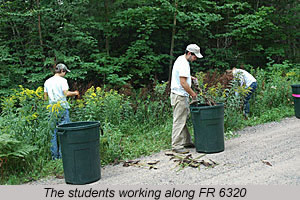 INVASIVE PLANT PROJECT
INVASIVE PLANT PROJECT
This was the second year of operation of our Invasive Plant Project which is funded by a 3-year grant from the US Forest Service. We again hired 3 part-time students: two new students, Haily and Eric, and Ben who was a member of last year’s team. The students and the two volunteer project leaders, Dan W. and Wally B., spent more than 30 days in Sylvania. Several local and out-of-state volunteers (David and Carol S., Jan K., John R., Anne H., Tom C., Bob and Lorena E., Bob T., and Jim F.) provided additional invaluable assistance. They and the project leaders donated over 800 hours of field work.
Early in the season, we hiked through the western edge of Sylvania checking the 67 known Japanese barberry sites (29 sites provided to us by the Forest Service when we started in 2011 and 38 sites we identified in 2011), and discovering another 32 sites this year. Plants inside the wilderness were pulled,  those outside were cut and treated. In June and July we searched for and pulled thistles (European swamp, Canada, and bull) along lake shores, on islands, as well as in some interior locations. We checked over 100 known thistle sites and added almost 200 new sites. We mowed the large spotted knapweed patch on north beach of Clark Lake and pulled plants around the perimeter. We also mowed and pulled invasive plants along sections of the roads in the Recreational Area north of the wilderness, the likely source of many invasives now in the wilderness. Our last project of the season was pulling invasives (curly dock, thistles, spotted knapweed, and sweet clover) along the nearly 10 miles of FR 6320, which took the 3 students, 2 leaders, and several volunteers about 2.5 days; we filled roughly 35 construction-size plastic bags with seed heads. Removing invasives along FR 6320 is critical since the road runs along the eastern boundary of the wilderness and is therefore a potential source of invasives. On a sad note: we discovered a new patch of garlic mustard at the Squirrel campsite. Last year, when we found garlic mustard plants only at the Birch and none at the Ash campsite, we thought we had reduced the number of sites to one. It is now sadly back up to two. All three garlic mustard sites are located at campsites, which means that the vectors are people and/or their furry companions.
those outside were cut and treated. In June and July we searched for and pulled thistles (European swamp, Canada, and bull) along lake shores, on islands, as well as in some interior locations. We checked over 100 known thistle sites and added almost 200 new sites. We mowed the large spotted knapweed patch on north beach of Clark Lake and pulled plants around the perimeter. We also mowed and pulled invasive plants along sections of the roads in the Recreational Area north of the wilderness, the likely source of many invasives now in the wilderness. Our last project of the season was pulling invasives (curly dock, thistles, spotted knapweed, and sweet clover) along the nearly 10 miles of FR 6320, which took the 3 students, 2 leaders, and several volunteers about 2.5 days; we filled roughly 35 construction-size plastic bags with seed heads. Removing invasives along FR 6320 is critical since the road runs along the eastern boundary of the wilderness and is therefore a potential source of invasives. On a sad note: we discovered a new patch of garlic mustard at the Squirrel campsite. Last year, when we found garlic mustard plants only at the Birch and none at the Ash campsite, we thought we had reduced the number of sites to one. It is now sadly back up to two. All three garlic mustard sites are located at campsites, which means that the vectors are people and/or their furry companions.
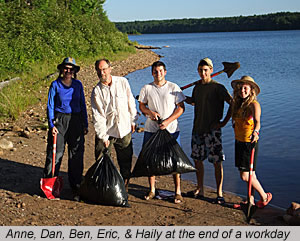 We have been pulling plants and cutting off flowers and seed heads of several invasive species for only two field seasons, but we are already beginning to see evidence of the effectiveness of our work. For example, in 2011 it took 3 people over 6 hours (a total of 18 work hours) to pull all of the thistle plants we discovered on top of Deer Island Lake island. In 2012, it took 5 people only 0.75 hours (a total of 4 work hours) - a reduction of 75% - because there were fewer plants in 2012.
We have been pulling plants and cutting off flowers and seed heads of several invasive species for only two field seasons, but we are already beginning to see evidence of the effectiveness of our work. For example, in 2011 it took 3 people over 6 hours (a total of 18 work hours) to pull all of the thistle plants we discovered on top of Deer Island Lake island. In 2012, it took 5 people only 0.75 hours (a total of 4 work hours) - a reduction of 75% - because there were fewer plants in 2012.
In early August, the Forest Service announced the availability of another round of Title II RAC money. We submitted a proposal for two additional years of funding for our invasive plant project (2014 & 2015). Of the 12 proposals submitted, ours and 6 others were funded. The amount we were granted was the second highest in terms of dollar amount and % of request, attesting to the quality of our work. The granted funding level for years 2013, 2014, and 2015 does, however, represent only about 66% of what we would need in order to operate the project at the 2012 level. Therefore, our need for volunteers and additional funding is considerable.
NATIVE PLANT GARDEN
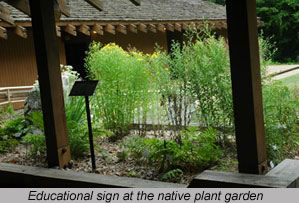
In spite of the drought, almost all of the plants growing in the Native Plant Garden at the Day use building came back this year. An educational sign that we designed last winter was installed in spring. The Forest Service installed a beautiful Mason bee nesting structure made of bamboo tubes. The bees – great pollinators - must have found it since, by fall, several of the tube openings were plugged (meaning that the females had deposited eggs).
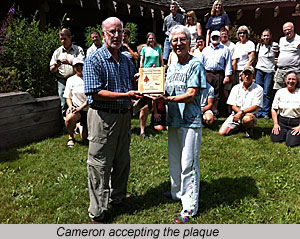 CELEBRATION AT SYLVANIA
CELEBRATION AT SYLVANIA
The Michigan Wilderness Act of 1987 designated several Michigan landscapes as wilderness, including the Sylvania Wilderness. The Michigan Sierra Club celebrated the 25th anniversary of this act by hosting events at three locations, one of which was Sylvania. The celebration at Sylvania, on July 15, consisted of a panel discussion to which the Friends of Sylvania were invited and a delightful picnic at the Day use building. At the picnic, we took the opportunity to present a plaque to Cameron Coleman and his wife Mary Carol (who could not be present) in appreciation of their many years of volunteer service in Sylvania.
TRAIL CLEARING CREW
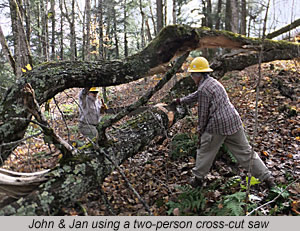
Every year, high-wind events deposit tree trunks and tops of various sizes across portages and hiking trails, including some trunks with diameters of over three feet. Every year, for two decades, Dan and his highly skilled trail clearing crew clear the trail obstructions with nothing but a two-person cross-cut saw, a couple of bow saws and an ax since motorized devices are not permitted in a wilderness. In September and October, three crew members (Dan W., Jan K., and John R.) drove up from Madison three times to clear all of the trails, except for the Clark Lake shore loop. Significant trail clearing assistance was provided by Bob T., Tom W., 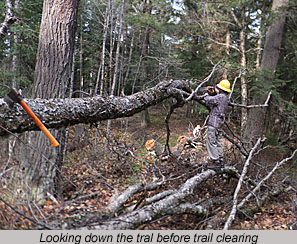 Jim F., and Dan B. for the southeast corner of Sylvania. The information as to where trees were down came from visitors who left notes at the Entrance Station, our invasive plant crew, the Land O'Lakes saw team, and Forest Service employees (this year, two Forest Service LTEs were particularly helpful). Skiing, snowshoeing, and hiking on Sylvania’s trails this winter should be a delight (we are hoping for lots of snow).
Jim F., and Dan B. for the southeast corner of Sylvania. The information as to where trees were down came from visitors who left notes at the Entrance Station, our invasive plant crew, the Land O'Lakes saw team, and Forest Service employees (this year, two Forest Service LTEs were particularly helpful). Skiing, snowshoeing, and hiking on Sylvania’s trails this winter should be a delight (we are hoping for lots of snow).
CROOKED LAKE BOAT LANDING FOR CARRY-DOWN BOATS ONLY
The Forest Service staff has been diving and pulling and occasionally treating Eurasian water-milfoil in the north bay of Crooked Lake ever since that plant was discovered there in 2002. Some years the number of milfoil sites was down; other years new sites were discovered, most likely due to weeds brought in on boat trailers. This was one reason why the  Friends of Sylvania last year joined several other environmental groups in expressing support for the Forest Service plan to modify the Crooked Lake boat landing to make it into a carry-down facility by installing a gate. In the spring of 2012, thanks to the Forest Service, a gate was installed. Only one shoreline property owner, the owner of Foxes Den, and her guests have the legal right to use motor boats in the wilderness and she therefore had a key to the gate. Nevertheless, the motor boat traffic on Crooked Lake was significantly less this year and we are all delighted that fewer aquatic invasives were transported into the lake. The agreement between the Forest Service and Foxes Den regarding the gate expired on 12/31/2012. The elimination of trailered boats entering the lake from the Sylvania boat landing will move us even closer to our ultimate goal of eradicating Eurasian water-milfoil from Crooked Lake.
Friends of Sylvania last year joined several other environmental groups in expressing support for the Forest Service plan to modify the Crooked Lake boat landing to make it into a carry-down facility by installing a gate. In the spring of 2012, thanks to the Forest Service, a gate was installed. Only one shoreline property owner, the owner of Foxes Den, and her guests have the legal right to use motor boats in the wilderness and she therefore had a key to the gate. Nevertheless, the motor boat traffic on Crooked Lake was significantly less this year and we are all delighted that fewer aquatic invasives were transported into the lake. The agreement between the Forest Service and Foxes Den regarding the gate expired on 12/31/2012. The elimination of trailered boats entering the lake from the Sylvania boat landing will move us even closer to our ultimate goal of eradicating Eurasian water-milfoil from Crooked Lake.
EXTRAORDINARY LOON RESCUE
in the fall, the Friends of Sylvania were part of an extraordinary loon rescue. On October 20, some fishermen in Sylvania noticed a loon chick entangled in fishing line on Crooked Lake and mentioned this to our trail clearing crew working on the north end of Loon 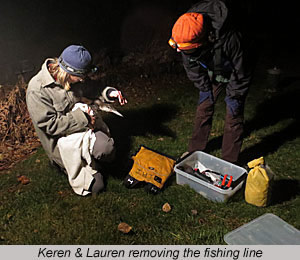 Lake. Dan passed the report on to Wally who passed it on to Tom C. (a Watersmeet resident and our newest board member). Tom and Tim S. (the owner of the Sylvania Wilderness Cabins located on the north end – the first bay - of Crooked Lake) went out on the lake and found the loon in the second bay all by itself – the other loons had already left for their seasonal migration to warmer climates. A fish hook was embedded in the neck of the loon chick and the fishing line was wrapped around the beak. The fishing line apparently prevented the chick from extending its neck to achieve normal flight posture. Tom and Tim tried to capture it but were unable to get closer than 10 feet. The following day, Tom organized a rescue team consisting of Keren Tischler (Common Coast Research, a nonprofit organization dedicated to the protection of loons) and Lauren Romstad (US Forest Service). The team arrived after dark and was able to find the chick in the second bay because Tim had gone out on the lake early in the evening to monitor the chick’s location. It was caught with the help of a high-powered spotlight that temporarily blinded it. Back at the Sylvania Wilderness Cabins, the fishing hook and line were carefully removed. The injuries, while visible, appeared to be minor and the help of a veterinarian was not needed so the loon was released. For about a month, the loon chick was diving, eating, and doing short flights to exercise its muscles and wings. This was one lucky chick! The extended fall with a late freeze-up provided the needed recovery period. On November 20, Tom went out on the lake and did not find the loon chick that had been on the lake the day before; so we have every reason to think that it made a successful departure to warmer climates. The lake started to freeze over a couple of days later. The rescued chick was one of only two chicks hatched on Crooked Lake this summer.
Lake. Dan passed the report on to Wally who passed it on to Tom C. (a Watersmeet resident and our newest board member). Tom and Tim S. (the owner of the Sylvania Wilderness Cabins located on the north end – the first bay - of Crooked Lake) went out on the lake and found the loon in the second bay all by itself – the other loons had already left for their seasonal migration to warmer climates. A fish hook was embedded in the neck of the loon chick and the fishing line was wrapped around the beak. The fishing line apparently prevented the chick from extending its neck to achieve normal flight posture. Tom and Tim tried to capture it but were unable to get closer than 10 feet. The following day, Tom organized a rescue team consisting of Keren Tischler (Common Coast Research, a nonprofit organization dedicated to the protection of loons) and Lauren Romstad (US Forest Service). The team arrived after dark and was able to find the chick in the second bay because Tim had gone out on the lake early in the evening to monitor the chick’s location. It was caught with the help of a high-powered spotlight that temporarily blinded it. Back at the Sylvania Wilderness Cabins, the fishing hook and line were carefully removed. The injuries, while visible, appeared to be minor and the help of a veterinarian was not needed so the loon was released. For about a month, the loon chick was diving, eating, and doing short flights to exercise its muscles and wings. This was one lucky chick! The extended fall with a late freeze-up provided the needed recovery period. On November 20, Tom went out on the lake and did not find the loon chick that had been on the lake the day before; so we have every reason to think that it made a successful departure to warmer climates. The lake started to freeze over a couple of days later. The rescued chick was one of only two chicks hatched on Crooked Lake this summer.
Wishing you a happy and peaceful 2013,
Friends of Sylvania Board of Directors:
Wally Brinkmann Tom Church Craig Coleman Bob Evans Dan Wallace
